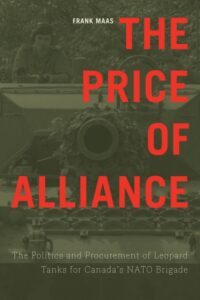
Frank Mass, The Price of Alliance: The Politics and Procurement of Leopard Tanks for Canada’s NATO Brigade (Vancouver: UBC Press, 2017), reviewed by Dr. Peter Kasurak.
~ ~ ~
Tanks are a litmus test for Canadian defence and foreign policy. How one views tanks can reveal preferences for defence budget levels, overseas engagement, UN and alliance policy and a host of other considerations. Ownership of tanks raises issues of foreign policy, civil-military relations and the technicalities and politics of major procurements. The Price of Alliance by Frank Maas explores all three of these dimensions.
Maas’ book begins with Paul Hellyer’s 1964 Defence White Paper and ends in 1975 with the acquisition of the Leopard tank by Pierre Trudeau’s government. During this decade, the army faced the necessity of replacing its aging Centurion tanks while the government underwent two major defence policy revolutions: the first being Hellyer’s quest for the creation of a “mobile force” and the integration and unification of the Canadian Forces; and a second when the value of the NATO alliance came into question during the Trudeau government’s tenure. At issue were questions of whether the army should be equipped with a main battle tank or a lighter “Direct Fire Support Vehicle” (DFSV) that would be air portable and whether the Canadian brigade group should remain on NATO’s Central Front or even be stationed in Europe at all. Maas makes it clear that the debate did not simply pit civilians against military officials. One side included “traditionalists” in the foreign and defence policy communities, as well as Prime Minister Lester Pearson and members of the both the Pearson and Trudeau cabinets, who supported continuing with a heavy brigade group on the Central Front. On the other side, the “revisionists” consisted not only of the new guard in Trudeau’s cabinet and the prime minister himself, but also military modernizers like General Jean Victor Allard who wanted to equip the army with lighter, more modern equipment.
Probably the most written about episode in the Leopard tank story is Trudeau’s meeting with German Chancellor Helmut Schmidt, which is often summarized as the former caving to a threat by the latter, “No tanks, no trade.” Others contend that the CDS, General Jacques Dextraze, or U.S. Secretary of State James Schlesinger changed Trudeau’s mind. Maas considers all of these possibilities, but rejects them. While each man played a role, and Schmidt undoubtedly pressured Trudeau, Maas shows that Schmidt played a more subtle game by showing Trudeau that it was worth being part of the NATO club, and if tanks were the price of admission, then so be it. Maas also argues that Trudeau’s thinking on defence policy had evolved, making him more amenable to stationing Canadian forces on the Central Front.
The tank issue was also a major contributor to the decline of civil-military relations during the 1970s. As Minister of National Defence, Léo Cadieux was supposed to negotiate the removal of the Canadian brigade group from the Central Front and keep cabinet informed if there were problems in accomplishing this. In any event, neither occurred. Cadieux, along with Mitchell Sharp, another cabinet colleague, threatened resignation over the issue and prevented a complete withdrawal from Europe by obtaining cabinet consent to a “phased reduction.” When Donald Macdonald succeeded him as minister, he was horrified to discover that the army wanted to buy tanks and was still committed to the Central Front. Trudeau launched an investigation. In my book, A National Force, I concluded that Cadieux, with the support of Allard, had stretched out negotiations and kept cabinet in the dark. Maas takes a contrary view saying it is “unlikely” that Cadieux attempted to “fool” cabinet. But I am not convinced. It seems unlikely to me that a cabinet minister would simply forget to keep his colleagues informed of a key provision of an international negotiation and equally unlikely that he would not ensure that NATO was aware (which it was not) of Canada’s intent to withdraw from the Central Front. As there is no “smoking gun” document in the archives, readers will have to make up their own mind as to whose account is best.
The history of the Leopard tank as a procurement project is the least interesting part of the book, mostly because National Defence selected what it considered the lowest risk option and then both it and Kraus-Maffei executed the contract well. Maas makes a careful appraisal of the project, concluding that off-the-shelf worked well for the Leopard, but would not be a suitable approach for all major defence procurements.
This is a solid work based on extensive research. There is much new material presented that historians will want to access. It is also well-written for the general reader and underscores the fact that the light/heavy debate continues into the present given recent controversies over yet another Leopard tank and the associated Close Combat Vehicle.
~ ~ ~
Peter Kasurak, PhD, teaches from time to time in the War Studies and Public Administration departments of the Royal Military College of Canada. His recent book on the Canadian Army, A National Force: The Evolution of Canada’s Army, 1950-2000 (UBC Press, 2013), was shortlisted for the C.P. Stacey Prize. He retired from the Office of the Auditor General in 2007 as the Senior Principal for National Security audits.
